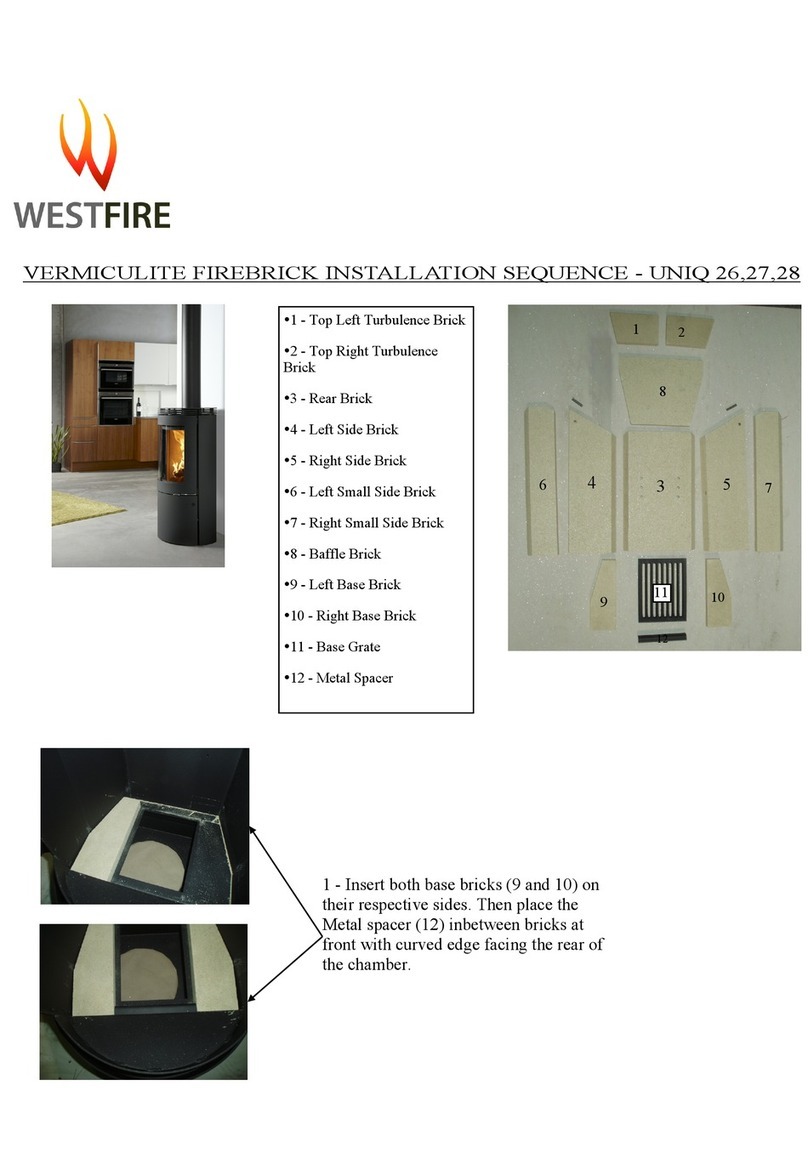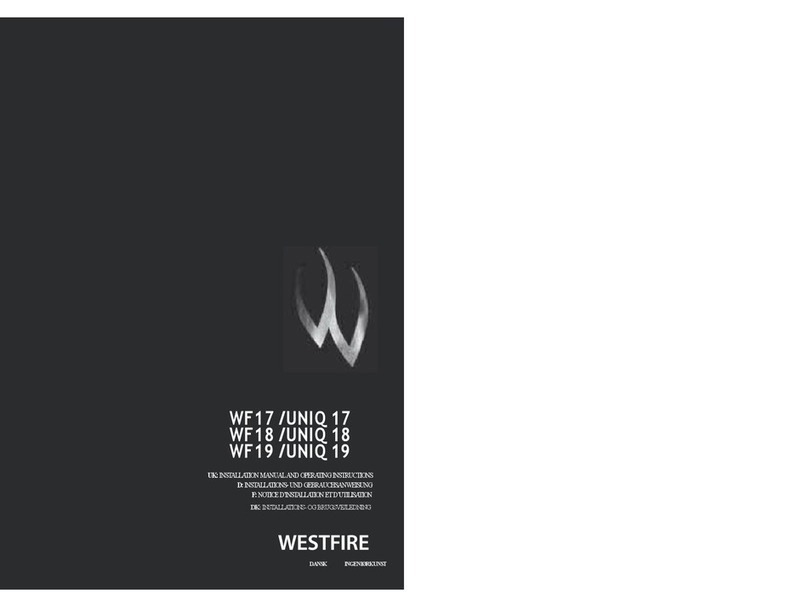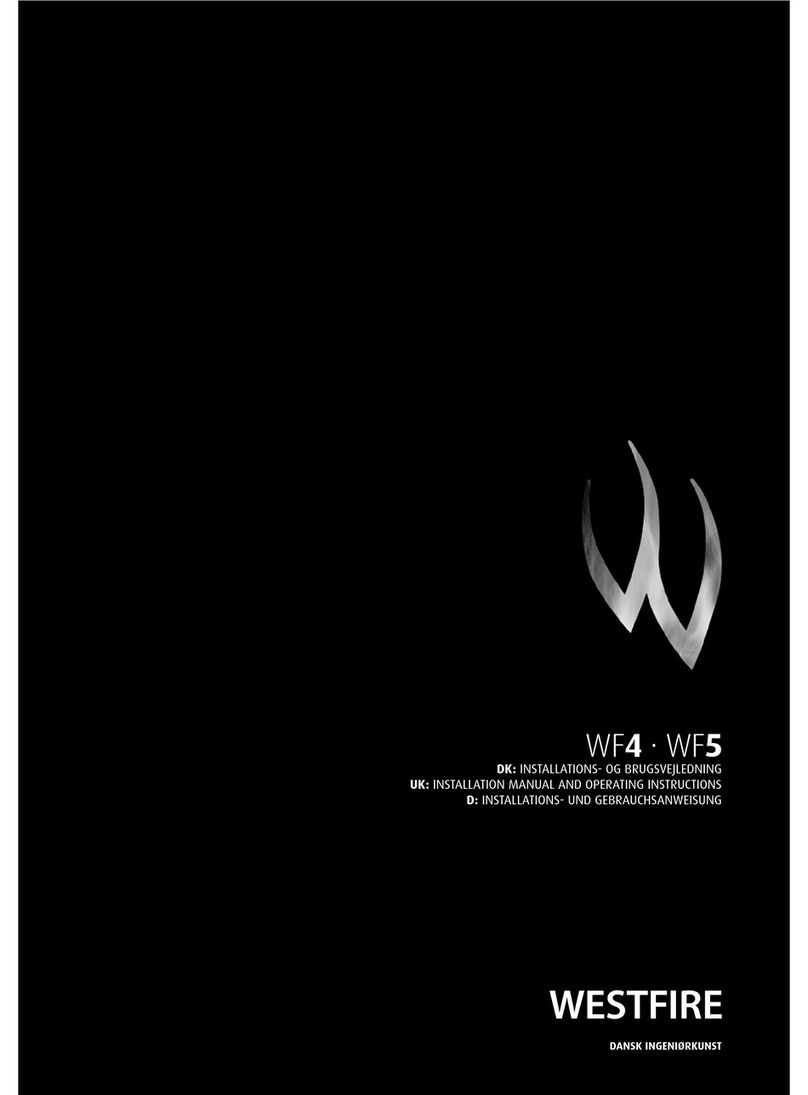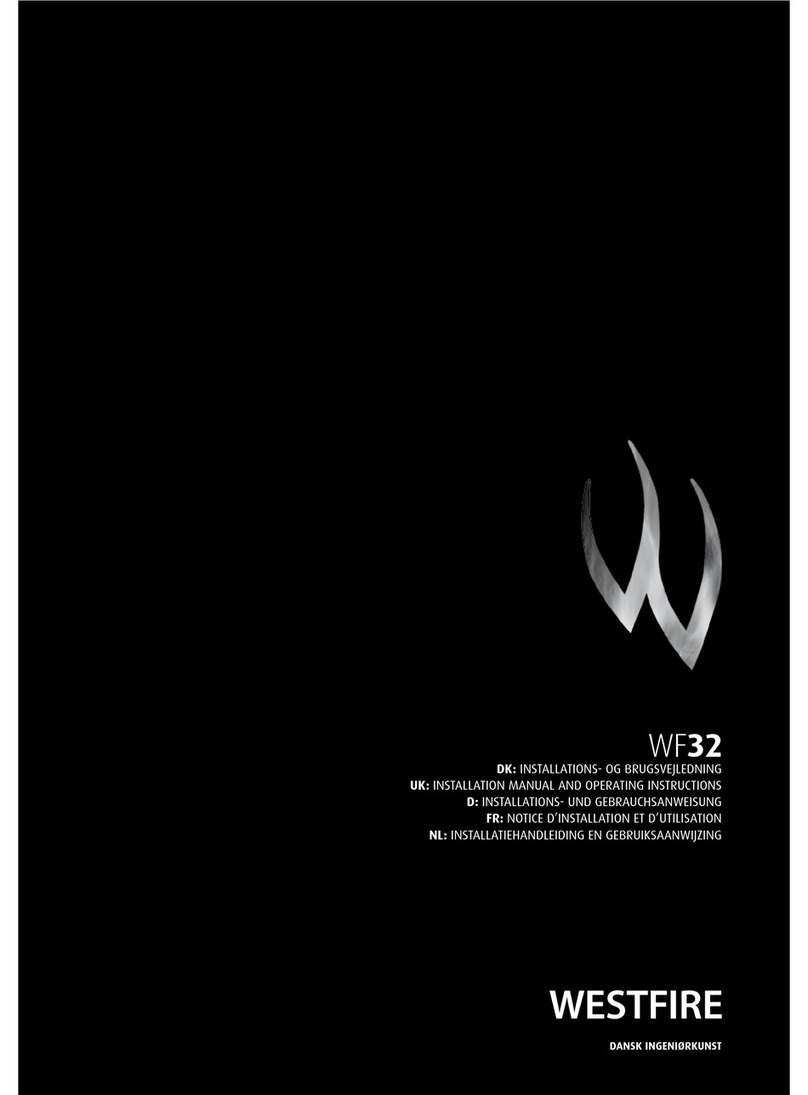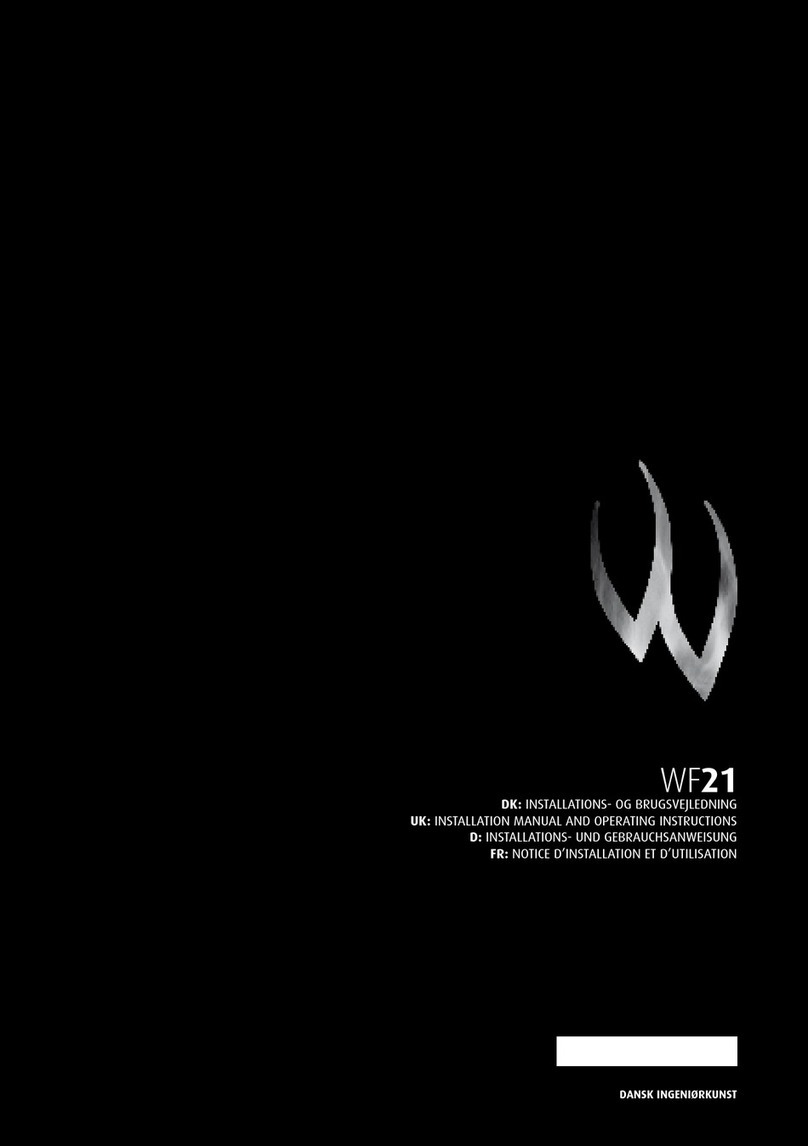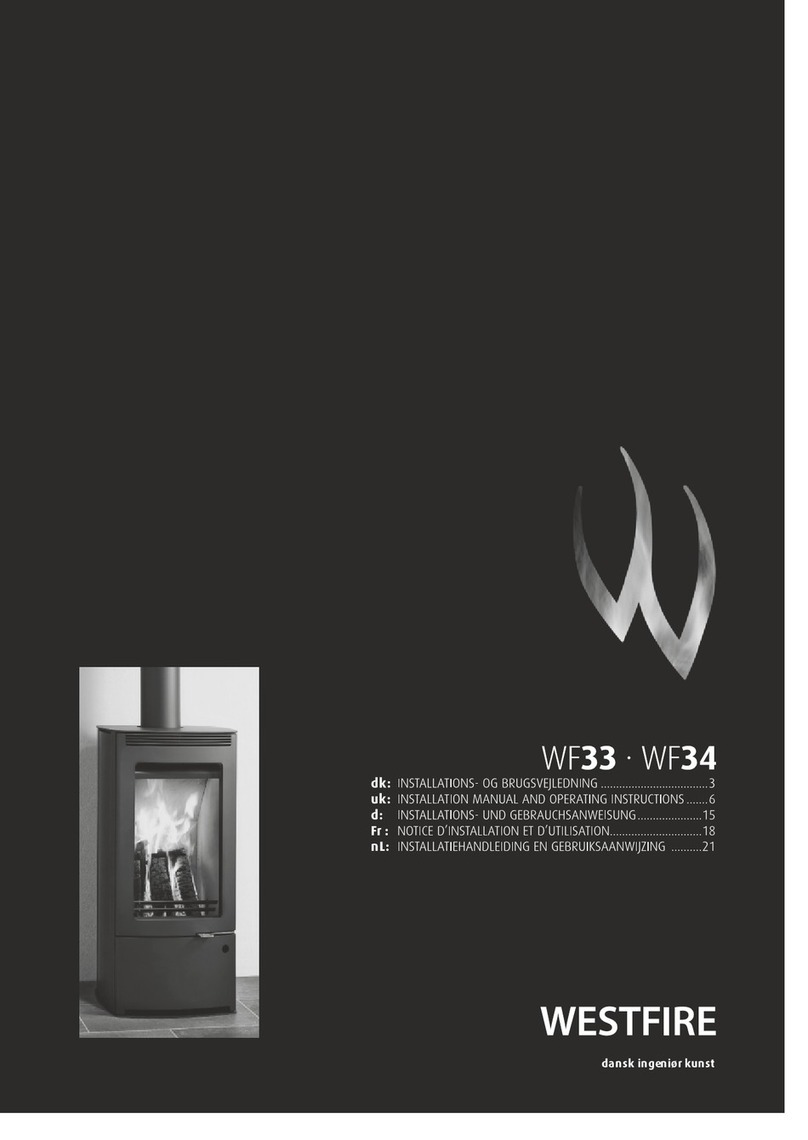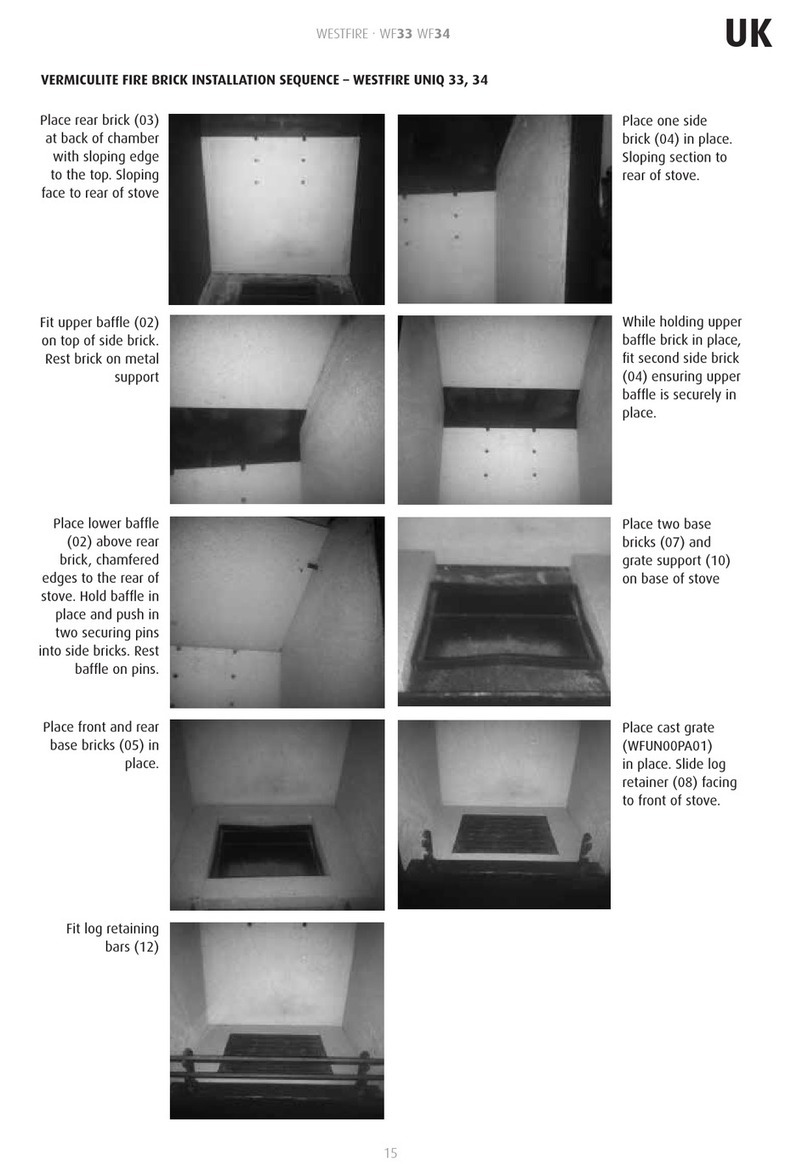
WESTFIRE · WF35 WESTFIRE · WF35
14 15
UK
Before refuelling, open secondary air control fully, open primary air control fully. Open door, add two pieces
of split wood measuring approximately 20cm with a combined weight of 1.15kg. Close the door and leave the
primary and secondary air controls open until fire is re-established with flames. Close primary air control and slide
secondary air control to the operational position (40% open).
BURNING WOOD IN A SMOKE CONTROL AREA
You must purchase a smoke control version of the Westfire Uniq 35 stove which is modified slightly to comply
with regulations. Any change to this modification will invalidate the stoves compliance for smoke control areas.
The Clean Air Act 1993 and Smoke Control Areas
Under the Clean Air Act local authorities may declare the whole or part of the district of the authority to be a
smoke control area. It is an offence to emit smoke from a chimney of a building, from a furnace or from any fixed
boiler if located in a designated smoke control area. It is also an offence to acquire an “unauthorised fuel” for
use within a smoke control area unless it is used in an “exempt” appliance (“exempted” from the controls which
generally apply in the smoke control area).
The Secretary of State for Environment, Food and Rural Affairs has powers under the Act to authorise smokeless
fuels or exempt appliances for use in smoke control areas in England. In Scotland and Wales this power rests
with Ministers in the devolved administrations for those countries. Separate legislation, the Clean Air (Northern
Ireland) Order 1981, applies in Northern Ireland. Therefore it is a requirement that fuels burnt or obtained for use
in smoke control areas have been “authorised” in Regulations and that appliances used to burn solid fuel in those
areas (other than “authorised” fuels) have been exempted by an Order made and signed by the Secretary of State
or Minister in the devolved administrations.
Further information on the requirements of the Clean Air Act can be found here: http://smokecontrol.defra.gov.
uk/ Your local authority is responsible for implementing the Clean Air Act 1993 including designation and super-
vision of smoke control areas and you can contact them for details of Clean Air Act requirements
Using your stove in a smoke control zone.
Only specific SE models are suitable for smoke control areas (see page 4), alterations should not be attempted.
Westfire smoke control stoves should not be burnt with the door left open.
The refuelling procedure: allow the newly charged fuel to burn with the secondary air control set at maximum for
up 3 to 4 minutes. After this period, with flames from the logs fully established, close the secondary air supply to
the low output setting. When operating at high output (secondary air set fully open) the new refuel charge does
not require any boost air to establish combustion.
Refuelling on to a low fire bed
If there is insufficient burning material in the firebed to light a new fuel charge, excessive smoke emission can
occur. Refuelling must be carried out onto a sufficient quantity of glowing embers and ash that the new fuel
charge will ignite in a reasonable period. If there are too few embers in the fire bed, add suitable kindling to
prevent excessive smoke.
To light your stove Smokeless Coal
1. Place a few smaller pieces of dry wood (kindling) in the stove on top of the nontoxic firelighters, place one or
two small dry split and small quantity of Smokeless coal.
2. Fully open the secondary air control above the stove door on right hand side. Fully open primary air control at
base left of stove. Pull open coal switch. The Uniq 35 stoves air controls are now fully open.
3. Light the firelighters and push door to closed position and close handle to 1st position; this will allow a small
gap in the door for more air to be supplied to stove during ignition period.
4. When the flames are established and the fire is burning brightly load 1.1 kg of smokeless coal and close door
latch to position 2 fully closed.
5. Once the fire is burning maintain the secondary air control 100%.
UK
6. Now the fully established fire bed is burning brightly. Maintain primary air control at 100%, this is the opera-
tional setting. For the stove to burn cleanly and efficiently primary air is needed, do not be tempted to shut the
fire down too early as this may cause smoke. At nominal heat output, expect to refuel your stove once every
two hours.
When lit, the stove will get very hot and due care must therefore be exercised. Please use a glove and operating
tool supplied when operating air controls.
RE-FUELING Smokeless fuel
To re-fuel your stove. Only refuel your stove when flames have died down and you have glowing embers.
Before refuelling open secondary air control fully, open primary air control fully. Open door and re load 1.1 kg of
smokeless coal. Close the door and leave the primary and secondary air controls open until fire is re-established.
Maintain secondary air control at 100% and maintain primary air control to it operational position (100% open).
Operational Position of air controls during operation and in adverse conditions
You need to become familiar with your stove in order to be able to regulate the air controls correctly, as outside
factors such as the quality and height of your chimney, the quality of your fuel and the external weather condi-
tions can alter the stoves operational settings and performance.
Very damp weather can affect the draw of the stove and therefor more secondary air may be needed to adjust.
Very still cold clear days induce more draught and the setting for secondary air may be less than nominal settings.
Such accommodations will become normal once you are familiar with your stove.
It is easy to see whether the stove is functioning correctly; incomplete combustion will be shown by
1) The inside of the fire chamber firebricks having a black dusty build up,
2) A build-up of hard shiny soot on the inside of the glass
3) Smoking chimney.
To prevent sooting of the chamber and glass introduce more secondary air, also check that your wood is dry.
It is important to check the draft conditions before lighting your stove. This may be done, for instance, by crum-
pling a piece of newspaper, placing it in the combustion chamber and lighting it. The draft conditions are good if
the smoke is drawn away through the chimney.
Door operation
When opening the door of your Westfire stove always wear the glove that is provided to protect your hand from
possible heat. The handle pulls out away from the door. When shutting the door push the door closed and push
handle firmly to the second closed position. The WF UNIQ 35 door handle has two positions position 1 holds the
door slightly ajar for starting, and position 2 is fully closed.
Recommended Fuels
Good quality wood is the most important factor in your stove working efficiently and cleanly. Always use dry split
firewood. The dryness of the firewood plays an important role since the use of wet wood results in poor fuel
economy and may cause a tarry sooty film on the internals of the stove.
The Westfire UNIQ 35 is tested to burn wood and smokeless coal. Wood briquettes can also be burnt but load
weight should be strictly adhered to. For a full list of suitable fuels, check with the official solid fuels approvals
body, HETAS or Solid Fuel Association. Do not overload stove as this can cause excessive heat and damage the
stove. ALWAYS KEEP FUEL LOAD BELOW TERTIARY PORTS AT REAR OF STOVE.
Only use fuels approved for use on heating stoves.
Do not burn liquid fuels, drift wood, finished wood, sawn wood, pallet wood, chipboard/plywood,
varnished wood or plastic coated wood, wood treated with preservatives, or house hold waste.
DO NOT EXCEED SPECIFIED FUEL WEIGHTS.
DO NOT BURN HOUSE COAL. DO NOT BURN HOUSEHOLD WASTE; THIS APPLIANCE IS NOT AN INCINERATOR.
HOUSE COAL AND PETROLEUM COKE ARE NOT SUITABLE FOR USE ON THIS STOVE; IT’S USE WILL INVALIDATE THE
